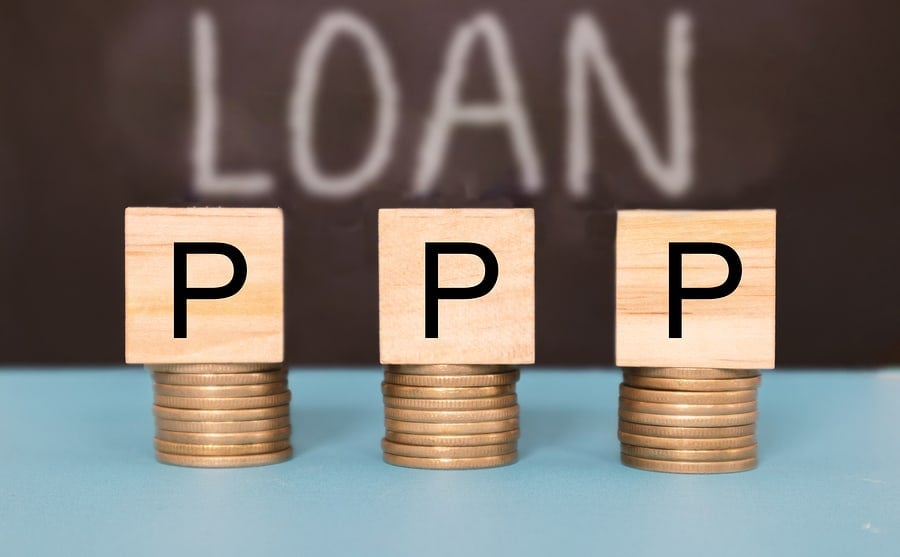
Need help getting funds? Get matched with lenders instantly
Answer some basic questions in less than 3 minutes with no impact to your credit score and compare multiple offers. No commitment, no hassle.
Get Matched💳 Save money on credit card processing with one of our top 5 picks for 2025

US small businesses and their workers are in a really tough spot right now. While some businesses are legally allowed to reopen, actually doing so presents a challenge for myriad reasons. Not only is customer behavior uncertain right now, as COVID-19 remains an ongoing threat to communities’ health and safety, but employees are also feeling uncertain about returning to work. Complicating the situation even further, businesses who recently received a Paycheck Protection Program (PPP) loan are now calling workers back. These businesses are required to spend the federal loan proceeds on payroll in order for the loan to be forgiven—but in some cases, the workers do not want to return, often because they are making more money on unemployment benefits.
In this article, I’ll offer some advice to business owners in this unprecedented situation. I’ll go over the rules relating to PPP loan forgiveness and payroll, as well as give you actionable advice on how you can still qualify for PPP forgiveness even if your employees won’t come back to work.
Table of Contents
As you are surely well aware, there are two main reasons employees don’t want to return to work right now:
These two factors are to some extent, related. For example, some employees might be willing to take on some degree of risk and return to work, but only if they have sufficient financial motivation to do so. But if they are making more money on unemployment than they would if they returned to work, then they would probably prefer to stay home.
Other workers may not be particularly worried about their health but still prefer to stay home for financial reasons. The CARES Act includes a $600-a-week supplemental payment in federal Pandemic Unemployment Compensation, on top of each individual state’s unemployment benefits. For many lower-wage workers, a $600/week pay raise is just too good to turn down.
Still other workers may be solely motivated by health considerations, and unwilling to come back to your workplace at any price. These individuals are probably looking for a work-from-home job or a job in a different industry that doesn’t pose as great of a health risk.
Overall, most employees are probably somewhere in the middle—concerned about their health on the job, but likely taking monetary considerations into account as well.
Can employees legally refuse to return to work and still collect unemployment benefits? The short answer is no, they can’t. When individuals file biweekly unemployment claims, the government asks them to verify that they have not received a job offer. If they have received an offer, they can no longer receive benefits. State unemployment agencies also routinely reach out to employers to verify the status of workers receiving benefits; if an employer states that someone has been offered a job and that person is still collecting unemployment, the state will investigate it.
Going a step further, some states are also advising employers to actively report COVID-19 return-to-work refusals to the state’s department of labor. For example, Vermont and Ohio have online forms where employers can report this type of “COVID-19 Fraud.”
Of course, this whole situation puts you in a tough spot as a small business owner. You may not want to cut off someone’s unemployment benefits or even get them in trouble, especially if you are sympathetic with the reasons why they don’t want to return to work. However, in order to meet the terms of loan forgiveness under the PPP, you will indeed need to document an employee’s refusal to return to work (more on PPP as it relates to your employees in a bit).
Employers should also be aware that there are certain exceptions for return-to-work requests, wherein furloughed employees may still be entitled to unemployment benefits even if they are ordered to return to work.
Employees who are unable to return to work because they are ill with COVID-19 or caring for a family member with COVID-19 may still be entitled to unemployment benefits. The same goes for employees who are caring for children at home due to COVID-related school closures, those with compromised immunity which makes them more vulnerable to COVID-19, and employees who face a high risk of exposure at their place of employment that the employer cannot address (for example, by providing employees with adequate personal protective equipment).
In some cases, the employee may be eligible paid or unpaid leave, which you may be able to use your PPP to pay for (even if they take unpaid leave you might still continue to pay their health insurance, for example), as this employee leave benefits are included under the umbrella of payroll expenses. However, the CARES Act expressly excludes using the PPP to pay for expanded COVID-19-related sick and family leave wages, for which a separate business tax credit is allowed—the Families First Coronavirus Response Act Paid Sick Leave Refundable Credit.
Finally, if a return-to-work offer is at reduced pay or reduced hours, the employee may still be eligible for full or partial unemployment benefits. You should also note that your PPP loan forgiveness will be reduced if you decrease salaries and wages by more than 25% per employee.
Considering all of the complex implications and outcomes of calling your employees back to work during the coronavirus pandemic, it’s crucial that you as a business owner familiarize yourself with all state and federal laws in regard to calling your furloughed employees back to work.
The PPP has certain rules about what you need to do in terms of the payroll portion of the loan in order to qualify for loan forgiveness. Note that it is still possible to qualify for full forgiveness on your loan, even if some employees do not return to work.
Here are the main rules you need to follow to qualify for full PPP forgiveness, as it relates to your employees and payroll:
There is an exemption which states that PPP recipients who have furloughed/laid-off employees who do not want to return to work can still get forgiveness on loans. Note: the exemption is just for maintaining your employee headcount; you’ll still need to spend 75% of the loan on payroll to qualify for forgiveness.
From the US Treasury Department’s FAQ page about PPP loans:
Question: Will a borrower’s PPP loan forgiveness amount (pursuant to section 1106 of the CARES Act and SBA’s implementing rules and guidance) be reduced if the borrower laid off an employee, offered to rehire the same employee, but the employee declined the offer?
Answer: No. As an exercise of the Administrator’s and the Secretary’s authority under Section 1106(d)(6) of the CARES Act to prescribe regulations granting de minimis exemptions from the Act’s limits on loan forgiveness, SBA and Treasury intend to issue an interim final rule excluding laid-off employees whom the borrower offered to rehire (for the same salary/wages and same number of hours) from the CARES Act’s loan forgiveness reduction calculation. The interim final rule will specify that, to qualify for this exception, the borrower must have made a good faith, written offer of rehire, and the employee’s rejection of that offer must be documented by the borrower. Employees and employers should be aware that employees who reject offers of re-employment may forfeit eligibility for continued unemployment compensation.
So what does that mean? Essentially, your business will not be penalized for reducing your headcount because an employee refuses to return to work, as long as you document the employee’s rejection of your offer (and the offer is for the same compensation and number of hours). However, to qualify for PPP loan forgiveness, you will still have to spend 75% of your loan on payroll expenses, which include employee compensation, taxes, and benefits. So, you will likely need to hire new employees if some of your old employees will not return. Remember, you can also spend up to 25% of your loan on other operating expenses, such as rent, mortgage, and utilities.
A couple more things to note are that you can use PPP funds to pay your furloughed employees to stay home (not return to work yet), and that you can increase employees’ wages and/or benefits so that you are spending the same amount on payroll, even if your headcount decreases.
There are several actions you can take if you received a PPP loan but your employees won’t come back. Each business’s situation is different so the best solution will depend on your particular circumstances. The most important thing is that you document the employee’s refusal to return to work so that you can present that when applying for PPP loan forgiveness; the other tips are optional and dependent on your situation.
Even if an employee has already expressed to you that they don’t want to come back, you need to present them with a good faith, written offer of rehire. In order to qualify for the PPP exemption that excludes laid-off employees whom the borrower has offered to rehire but refused to return, the employer needs to document the employee’s rejection of the return-to-work offer. Note that the offer must include the same number of hours and the same wages they were making before the crisis.
It’s advisable to have a discussion with your employee to find out why they don’t want to return to work. It may be the case that they would like to return but have a valid reason why they can’t, such as they cannot find childcare or they have a high-risk health condition that makes them especially vulnerable to risk of infection at the workplace. In those types of cases, your business may be eligible for a special COVID-19 tax credit if you offer the employee extended paid leave (though this credit cannot be combined with PPP).
If employees don’t want to come back because they are making more money on unemployment, you can gently remind them that in order to fulfill the terms of your PPP loan, you will have to document that they turned down your job offer, which will disqualify them from receiving unemployment benefits. You might also mention to them that the current expanded unemployment benefits will not last, and that it’s a difficult job market right now.
If unsafe conditions are at the forefront of your furloughed employees’ minds, it may be wise to make changes to your workplace and revise your health and safety policies. In addition to following all COVID-19-related CDC guidelines relevant to your industry, you can do your best to address specific employee concerns to make your workplace safer and increase social distancing.
Some workplace policy changes may be in order as well. For example, even if you didn’t previously offer paid sick days, you might consider updating your time-off policy to include some paid sick days.
Depending on whether you can afford to do so, you might consider offering returning employees temporary hazard pay, or even a permanent raise. You might also offer employees a non-monetary payroll benefit you previously didn’t offer, such as health insurance or PTO. Besides enticing employees to come back, increasing employee wages and/or benefits can help you meet the requirement to spend 75% of your PPP on payroll, especially if one or more employees will not return to work.
Of course, many businesses are hurting financially right now and aren’t in a great position to offer raises or expanded employee benefits. But with the proceeds of your PPP, you may be able to at least offer a temporary bonus or benefit.
If you so choose, you can use your PPP proceeds to pay employees to stay at home for up to 8 weeks. Most businesses will obviously not be able to do this while still maintaining operations, since you need employees to run your business. But it is an option.
Some businesses may choose to hire new employees to replace the employee(s) that are not returning. You need employees to keep your business operating, and again, you may also need to hire employees to meet the requirement that you spend 75% of your loan proceeds on 8 weeks of payroll. With current unemployment rates, it should not be too difficult to find workers right now.
Many businesses need a lot fewer employees than they did before the crisis, both because business is down and because they need to implement social distancing. So, the PPP forgiveness requirement to maintain employee headcount has a lot of businesses scrambling right now. If an employee doesn’t want to return, and you can document that they rejected your offer, you are “off the hook” in the sense that you don’t need to maintain your headcount and can still qualify for loan forgiveness. It’s still tricky in that you need to maintain your same payroll, but again, perhaps you can give everyone a raise or enhanced benefits to help offset the loss of an employee. Or, if you were initially planning to spend 100% of the loan on payroll, with one or two fewer employees, maybe you’ll now able to spend some of the loan (up to 25%) on other expenses like rent.
Remember that PPP forgiveness is not all-or-nothing. If some employees don’t want to come back and it’s not feasible to increase existing employees’ compensation or to find replacement employees in time, you may only qualify for partial forgiveness on your PPP loan. Or, maybe you don’t want to force an employee’s hand to make them formally reject your rehire offer, and thereby disqualify them from receiving unemployment benefits. Consider that even if you have to take a hit and won’t qualify for full loan forgiveness, your business could still benefit from a partially forgiven PPP loan.
Need more information about PPP loans and other COVID-19 related small business topics? Check out the following resources for further reading.
Further reading:
Want to help shape the future of the Merchant Maverick website? Join our testing and survey community!
By providing feedback on how we can improve, you can earn gift cards and get early access to new features.
 Our expert reviewers found BusinessLoans.com to have a quick and easy application process alongside excellent support and guidance for borrowers.
Start A Quick Application
Our expert reviewers found BusinessLoans.com to have a quick and easy application process alongside excellent support and guidance for borrowers.
Start A Quick Application
Help us to improve by providing some feedback on your experience today.
The vendors that appear on this list were chosen by subject matter experts on the basis of product quality, wide usage and availability, and positive reputation.
Merchant Maverick’s ratings are editorial in nature, and are not aggregated from user reviews. Each staff reviewer at Merchant Maverick is a subject matter expert with experience researching, testing, and evaluating small business software and services. The rating of this company or service is based on the author’s expert opinion and analysis of the product, and assessed and seconded by another subject matter expert on staff before publication. Merchant Maverick’s ratings are not influenced by affiliate partnerships.
Our unbiased reviews and content are supported in part by affiliate partnerships, and we adhere to strict guidelines to preserve editorial integrity. The editorial content on this page is not provided by any of the companies mentioned and has not been reviewed, approved or otherwise endorsed by any of these entities. Opinions expressed here are author’s alone.
 Our expert reviewers found BusinessLoans.com to have a quick and easy application process alongside excellent support and guidance for borrowers.
Start A Quick Application
Our expert reviewers found BusinessLoans.com to have a quick and easy application process alongside excellent support and guidance for borrowers.
Start A Quick Application
We Recommend Lendio 🏆
Lendio is one of our top picks for Business Financing!

Lendio is a free-to-use marketplace that allows you to compare lenders side-by-side.
Get started with no commitment today.